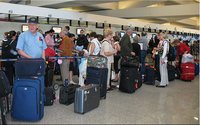Commentary
Airports Adding Sensors, Location Apps, Wearables, Virtual Reality
- by Chuck Martin , Staff Writer, October 3, 2016
 The
Internet of Things involves sensors and plenty of them are coming to airports to track pretty much anything or anyone who moves.
The
Internet of Things involves sensors and plenty of them are coming to airports to track pretty much anything or anyone who moves.
These technologies include beacons, Bluetooth and Wi-Fi and a quarter of airports already have installed some at checkpoint areas, up from only 17% a year ago, based on the latest global study by SITA, the airline industry organization.
Over the next three years, sensors will have become commonplace with the majority of airports installing them throughout the facilities, according to the study.
The 13th annual study took place in the second quarter of this year and comprised a survey of executives representing more than 225 airports, with half of respondents from airports among the top 100 in revenue.
The tracking sensors are being installed in range of locations, from security areas to stores. Here’s where airport sensors will be installed within the next three years, according to the study:
- 66% -- Security check points
- 61% -- Bag-drop areas
- 60% -- Retail areas
- 54% -- Boarding gates
- 52% -- Baggage claim
A third of airports already have incorporated IoT into their strategy while a further 43% plan to do so over the next three years.
In addition to sensors, airports are planning to install other IoT-related capabilities over the next five years. Here’s that breakdown of what’s coming:
- 74% -- Context and location aware applications for passengers
- 41% -- Wearables (smartwatches, smart glasses) for staff
- 41% -- Virtual reality services for passengers
- 36% -- Single biometric travel token for identify management
- 36% -- Specific wearable-enabled services for passengers
- 33% -- Artificial intelligence
The top investment priority for airlines is in passenger processing for more than half (59%) of them.
After cloud services, sensors at airports are the number one new technology initiative by 2019, with 81% of airports expecting to be in a major or evaluation program with them.
No word on whether this will help more planes depart or arrive on time. But at least the airlines will likely have a better handle on how many people are on the way and where they are.



